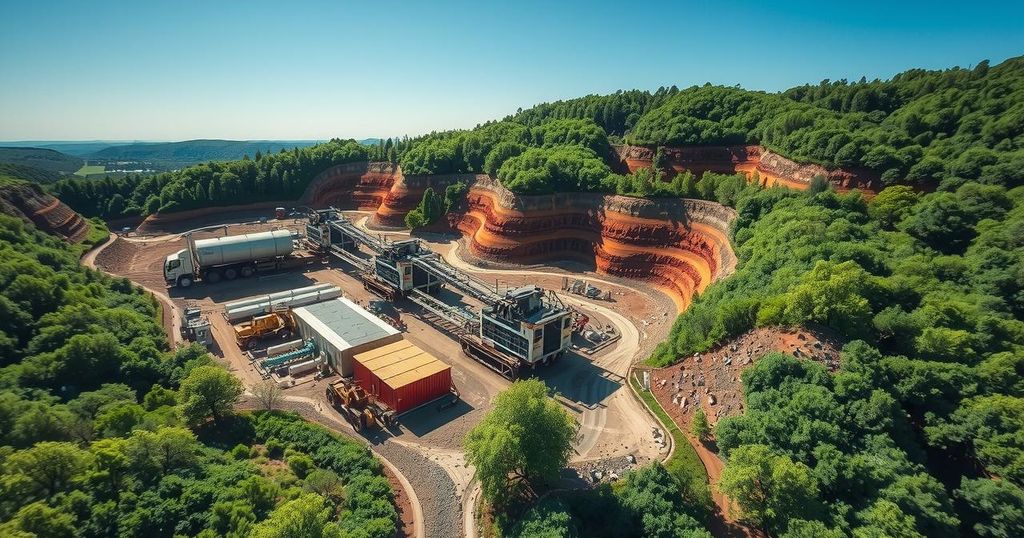Emerging Rare-Earths Markets: U.S. and Brazil Challenge China’s Dominance

The U.S. and Brazil are ramping up efforts to mine and refine rare-earths, reducing dependency on China. Aclara Resources is opening a mine and processing plant in the U.S., while Brazil boasts significant reserves but faces mining hurdles. The geopolitical landscape drives demand for alternatives to Chinese supply, highlighting a significant shift in this critical mineral market.
The landscape for rare-earth minerals is shifting. Countries like the United States and Brazil are increasingly investing in their capacity to mine these essential metals, used especially for electric vehicles and smartphones. A significant aspect is that a prominent share of these rare-earths is slated for U.S. markets, rather than China, which has been the dominant player in this arena for years. Currently, China mines approximately 70% of the world’s rare earths, yet it holds an even larger 90% share in processing these minerals — a fact alarming to many officials in other nations seeking supply security.
Ramón Barúa, CEO of Canada’s Aclara Resources, is directly involved in efforts to counter China’s dominance. Aclara is in the process of opening a rare-earths mine which will supply a processing facility they intend to build within the U.S. According to company announcements, by August they plan to finalize plans for the location of this processing plant. Aclara has secured a buyer, having inked a deal last year with VAC, a German firm receiving significant Pentagon funding for constructing a factory in South Carolina, where rare-earth magnets will be produced.
Amid geopolitics and trade tensions, interest in Brazil’s rare-earths has surged. Following recent U.S. tariffs on China, Beijing has tightened its export restrictions on rare-earths, causing alarm among American manufacturers such as Tesla, who swiftly seek alternatives outside Chinese supply channels. Following a period of halted exports, rare-earth shipments have resumed this month for select companies. During a recent earnings call, Tesla CEO Elon Musk expressed optimism, saying, “Hopefully, we’ll get a license to use the rare-earth magnets.”
Brazil boasts the second-largest reserves of rare-earths globally, with about 21 million tons, as reported by the U.S. Geological Survey. This figure represents over 20% of the world’s known reserves, dramatically surpassing U.S. resources. Notably, Brazil also holds significant quantities of crucial heavy rare earths, like dysprosium and terbium, which are vital for maintaining magnet performance in electric vehicles under high temperatures. Despite this potential, Brazil has lagged in this sector due to complicated regulations and challenges in securing funding against established Chinese competitors.
Mining costs in Brazil are estimated to be around three times higher than those in China, which may lead to higher prices for Western buyers. Only a few companies in the West have mastered the processing of rare earths, and the learning curve is steep. Alexandre Silveira, Brazil’s Minister of Mines and Energy, highlighted the importance of identifying rare-earth deposits and further investigating potential resources from existing operations, citing, “This potential presents a significant opportunity.”
Brasilia’s recent push includes the launch of its first large-scale rare-earth mine last year, located near Nova Roma, approximately 90 miles away. This mine, developed with Denham Capital, is among the few globally to produce heavy rare earths and is under contract to ship most output to China. In the U.S., significant investments have been made to revitalize processing facilities and magnet factories that were idle during China’s years of growth in the market.
Efforts to bolster the sector gained traction after President Trump declared a national emergency concerning the U.S.’s dependence on foreign critical minerals and has made the recovery of this sphere a key focus. Similarly, the European Union aims to decrease reliance on Chinese minerals, targeting a goal of processing 40% of critical raw materials needed within Europe.
Aclara is also expanding its efforts, with plans to invest around $600 million to establish a more extensive processing plant in Nova Roma capable of starting production by 2028. The facility will create rare-earth carbonates that can further be processed into individual elements once moved to the U.S.
While Aclara acknowledges that it cannot compete with pricing offered by China, it emphasizes its environmentally conscious approach to mining, in stark contrast to the industry standard in China, which has faced scrutiny over environmental degradation. Brazil’s own track record on mining is mixed, but current regulations are viewed as more stringent than China’s.
Additionally, Aclara’s strategy involves a careful excavation process to minimize environmental impact, opting to transport clays selectively instead of using traditional methods which are riskier. Erik Eschen, CEO of VAC, remarked that Aclara’s operation means they can avoid deep digging, leading to reduced contamination risk. As rare-earth processing evolves, the attention to environmental concerns is seen as a crucial difference between Aclara’s operations in Brazil and current practices in China.
The emergence of rare-earth processing and mining in the U.S. and Brazil represents a notable shift in the global landscape dominated by China. With countries like Brazil beginning to recognize and invest in their vast mineral resources, the U.S. also aims to substantially reduce its dependence on foreign supplies. Amid rising demand, the industry may witness significant changes, especially with environmentally conscious practices being a uniquely competitive edge. Overall, these developments may encourage a more balanced global market for essential rare-earth materials.
Original Source: www.hindustantimes.com




